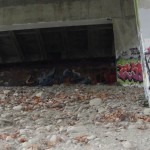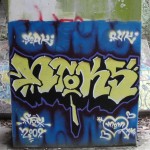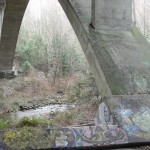The discussion of Graffiti often revolves around its public presence and the message that it carries with it, whether it be political, gang-related, or a social commentary.
However, graffiti also appears in places where it is not easily seen, and doesn’t actively work as a strong message. Well hidden under a North Vancouver Bridge is an improvised art gallery of graffiti that is constantly painted over and changed. It is situated near a popular hiking, trail, but most pieces are hidden behind the columns, which support the bridge, or deep in the shadows. In most cases, the artwork requires a good amount of hiking to even be seen.
In Jessie L. Whitehead’s article on the connection between students and art in a public space, he suggests that graffiti is a familiar occurrence in almost every city setting, and that it “offers an effective example of the connection between art and the world of everyday life”. In an area like North Vancouver, a large amount of the population consists of high school students, and graffiti can be seen as a more playful, quiet, well-hidden form of rebellion. Instead of on a popular building in the center of a city, these pieces are located in the wilderness, with very few viewers. This style can be seen as a personal expression, but not to the public as a whole. It is an expression only visible to those who know where to look. This suggests that graffiti has a more personal use as well.
– by Charlotte Z
Graffiti: The Use of the Familiar
Jessie L. Whitehead
Art Education , Vol. 57, No. 6 (Nov., 2004), pp. 25-32



